Nicknamed, “El rinconsito de nuestro pueblo” (“The little corner of our town”), Plaza Fiesta is a hub for Latin American products, foods, and culture. Located in the Atlanta suburb Chamblee, the indoor Latin mall is known for its variety of Latin restaurants, frequent family-oriented events and activities, and abundance of fashion retailers which predominantly carry western wear, Quienceñera dresses, and ethnic clothing. This small-scale research report will focus on these fashion retailers, discussing the types of clothing available for sale at Plaza Fiesta, particularly noting the differences between items marketed to women and those marketed to men.
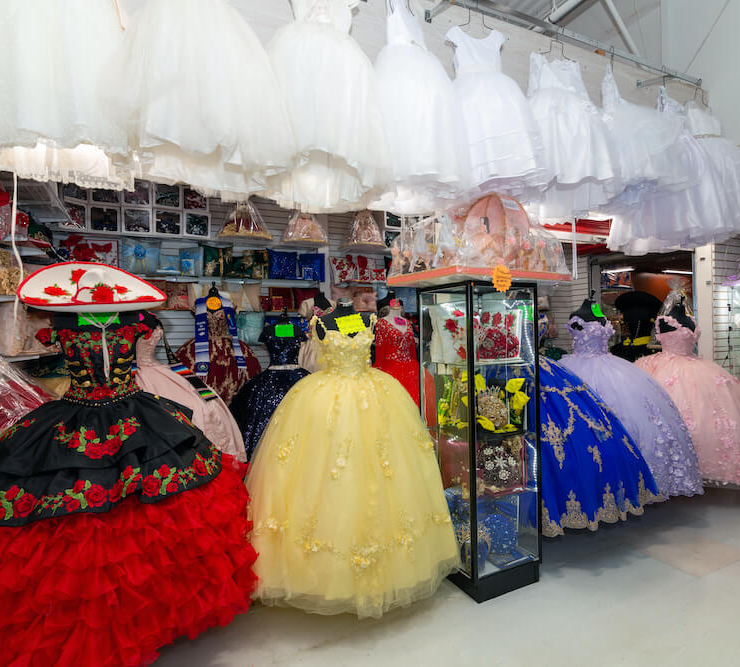
Background about the Plaza Fiesta Area
Before diving into the observations on the clothing at Plaza Fiesta, it is worth providing some background information about the location of the mall in order to expand on the previous point of it being a hub of Latin American culture. Plaza Fiesta’s location, Chamblee, Georgia, lies alongside Buford Highway, a 10-mile corridor previously referred to as Dekalb County’s International Corridor. Within an approximate 5-mile radius of Plaza Fiesta, there are at least four census-identified neighborhoods with populations comprised of at least 30% of foreign-born individuals: two neighborhoods in Brookhaven, with approximately 3,141 foreign-born individuals (~37.88% based on a population of about 8,290 people) and two neighborhoods in Chamblee, with about 11,334 foreign-born individuals (~31.70% based on a population of about 35,742 people). Furthermore, per the census data, the country of origin with the greatest number of residents for all four of these neighborhoods was Mexico. In three of the four, the second greatest number of residents came from Guatemala. Ecuador was the third country of origin with most residents in the two Chamblee neighborhoods. Other countries of origin with significant number of residents included Peru, Honduras, Spain, Belarus, Syria, Bangladesh, and Ethiopia. In brief, while very culturally diverse, it is clear per the data that many of the residents around the Plaza Fiesta area come from Latin American, and more specifically Central American, countries of origin.
Method
For the purposes of drawing distinct observations based on gender, I categorized each store per one of the following four categories: Men, Women, Women and Men, and Children’s. I categorized the stores in this manner based on the “tags” associated with each retailer denoted on the Plaza Fiesta website. These tags can be found by going to the stores tab on the website, selecting the “Products/Productos” category, and then selecting the individual retailer.
With this standardized understanding of which stores marketed items to women, men, or both, I walked through Plaza Fiesta on a busy Sunday afternoon. Specifically, I visited Plaza Fiesta on Easter, Sunday (2023), and despite it being a holiday, nearly all stores were open. Notably, Plaza Fiesta had advertised a live musical performance that would be occurring on this day, which may have attracted a larger crowd and consequentially encouraged many vendors to open shop that day. In fact, the only stores I was unable to go to this day was the chain clothing store, Ross Dress for Less. As I walked through, I aimed to take pictures, using my personal cellphone device, of each unique article of clothing I saw on display. The goal was to capture an image of each different type of clothing item at least once.
Results
Overview
In all, there are approximately forty-seven (47) distinct shops that sell apparel at Plaza Fiesta. Of these, I labeled 16 as “Women’s Wear”, 6 as “Men’s Wear”, 22 as “Women and Men”, and 4 as “Children’s”. For the purposes of this report, I will not be commenting on articles sold by children’s clothing retailers because none of these retailers subdivided their items by “girl’s” or “boy’s” clothes explicitly while clothing stores for adults did. Therefore, the following sections will go into more detail about the types of clothing available for the first three target demographics identified.
Women’s Wear
Of the sixteen clothing stores I identified that catered specifically to women, I found that 5 stores predominantly sold Quinceañera dresses, 4 focused on women’s intimates (including “fajas”, i.e., shapewear), 4 carried casual wear, 2 sold artisanal clothing/accessories (including traditional cultural garments), and 1 sold formal evening wear.
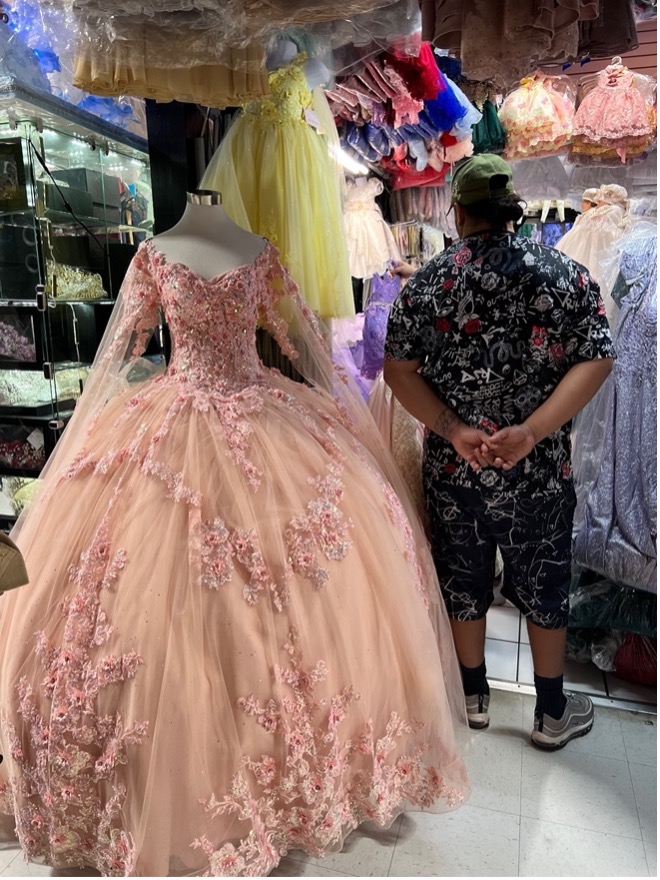
Notably, stores that focused mainly on Quinceñera dresses also sold wedding dresses and christening and baptism outfits, and the outfits appeared to target a wide range of ages, including infants, young girls, teenagers, and adult women. Except for one of the stores that sold artisanal and traditional clothing, I did not observe that any other stores – marketing to women – that sold clothing for a range of ages like this. Further, I observed that only one of these Quinceñera dress stores had formal suits for infant/toddler boys on display. Even though these shops selling clothing traditionally exclusive to women, I observed that shoppers browsing through them included both men and women. Thus, although selling women’s wear, these stores cater to family-centered occasions, and all members of the family join in on choosing the items that will be purchased from these stores.
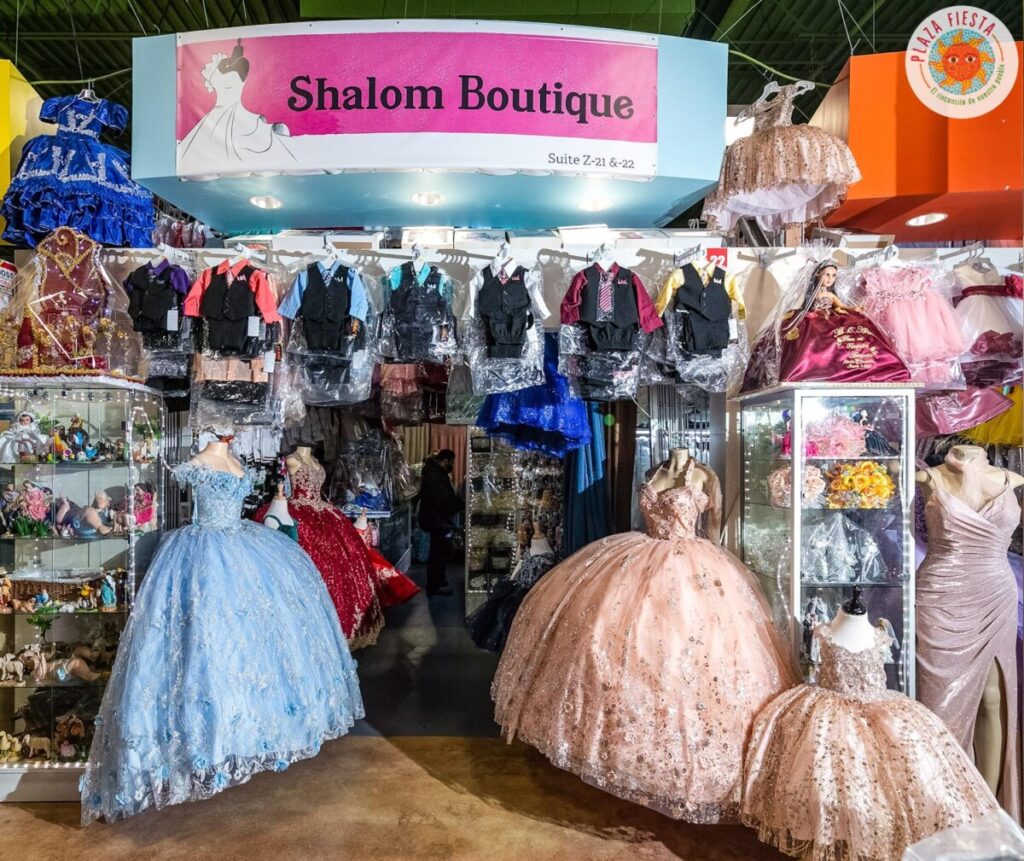
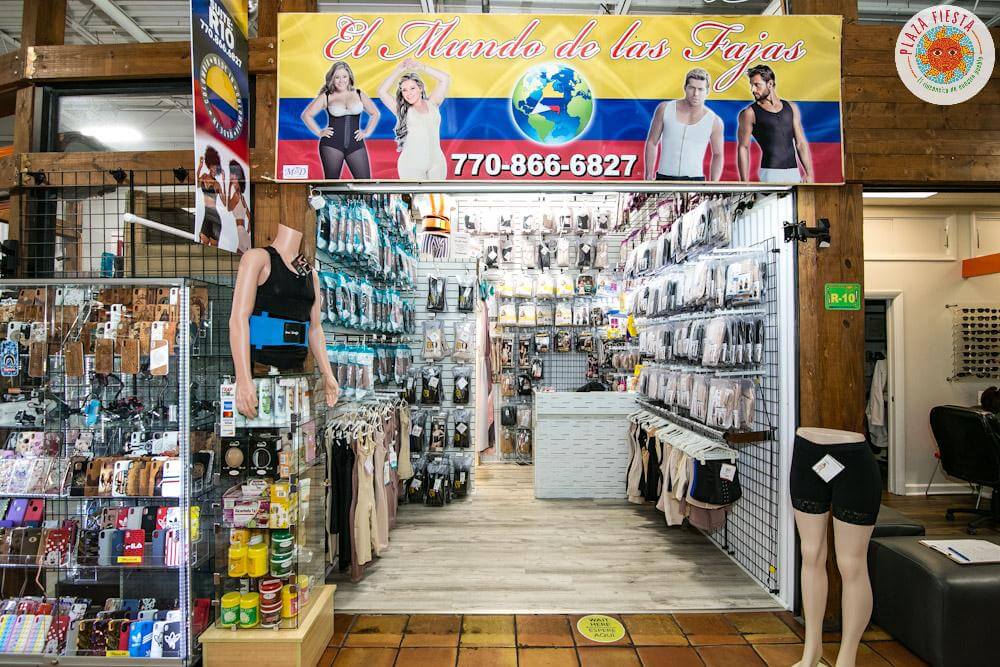
A couple more interesting observations when studying the clothes marketed specifically to women at Plaza Fiesta was the range of clothing options at shops that sold casual wear. One shop seemed to cater inclusively to all women, independent of what level of modesty they wanted to dress with, carrying items such as long-skirt suits, shawls and cardigans, and blouses on one end of the store and cropped tops, cutout dresses, and ripped jeans on the other end of the store. This layout choice most likely was simply the result of trying to lay out the clothing articles based on the predicted age range of who they would appeal to (teenagers and young adults versus older women). Lastly, one of the last items that caught my attention was not a particular article of clothing but a store sign for one of the women’s intimates’ stores. The sign on this store, called El Mundo de las Fajas (Girdles World Colombian Shapewear, in English per their Facebook website), was male and female models posing in shapewear above a Colombian flag. Knowing that Colombia was not one of the top countries of origin per the census data, it was interesting to see a vendor, presumably, of Colombian heritage at Plaza Fiesta. It was also interesting to see how they incorporated a symbol of national identity, the flag, as a main part of the storefront.
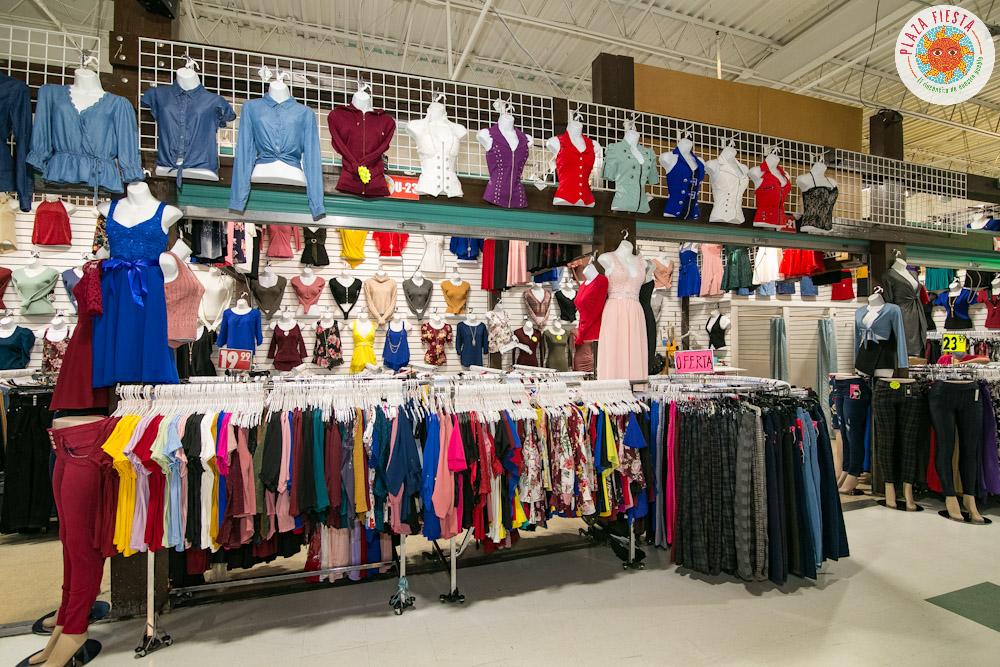
Men’s Wear
Clothing retailers that exclusively sold men’s wear made up the smallest subset of the clothing shops at Plaza Fiesta (considering that the children’s clothing stores were not categorized by gender). Of the nine men’s wear shops, 4 sold casual wear and 2 were formal wear.
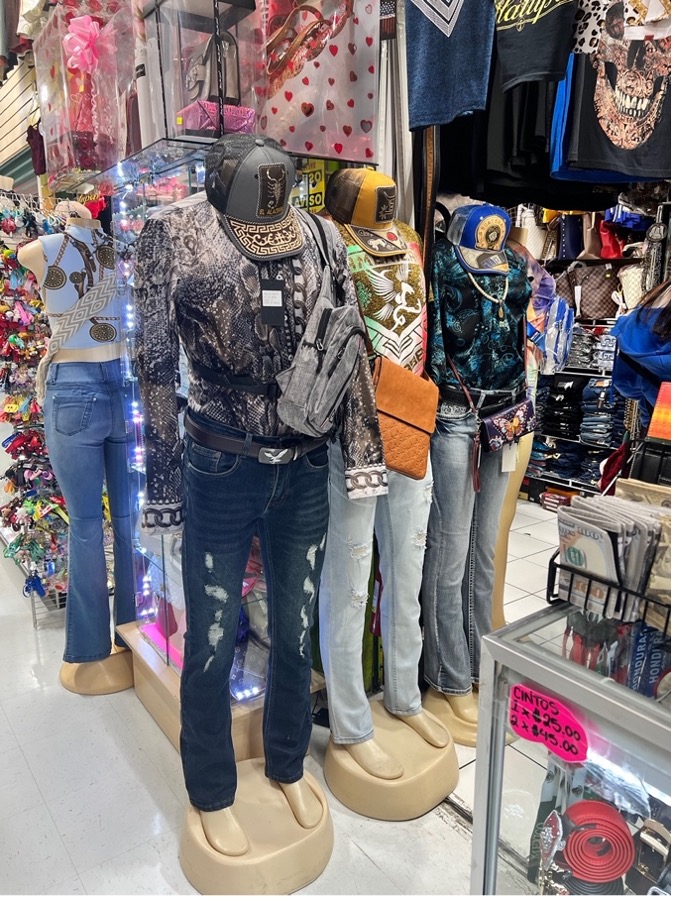
In looking at these casual wear stores, one item to note is the emphasis on accessories available to purchase meant to complement the articles of clothing for sale. It caught my attention that nearly all men’s wear stores had items such as hats, belts, wallets, and shoes at the forefront of the shop. Furthermore, mannequins dressed in men’s wear sported these accessories, jewelry, and bags (such as fanny packs and messenger bags). In addition, it was interesting to see that while only two of the men’s wear stores labeled themselves as formal wear, nearly all the men’s wear stores sold long-sleeve button-up shirts, a clothing item I would have personally considered to be formal or, at least, more formal than casual.
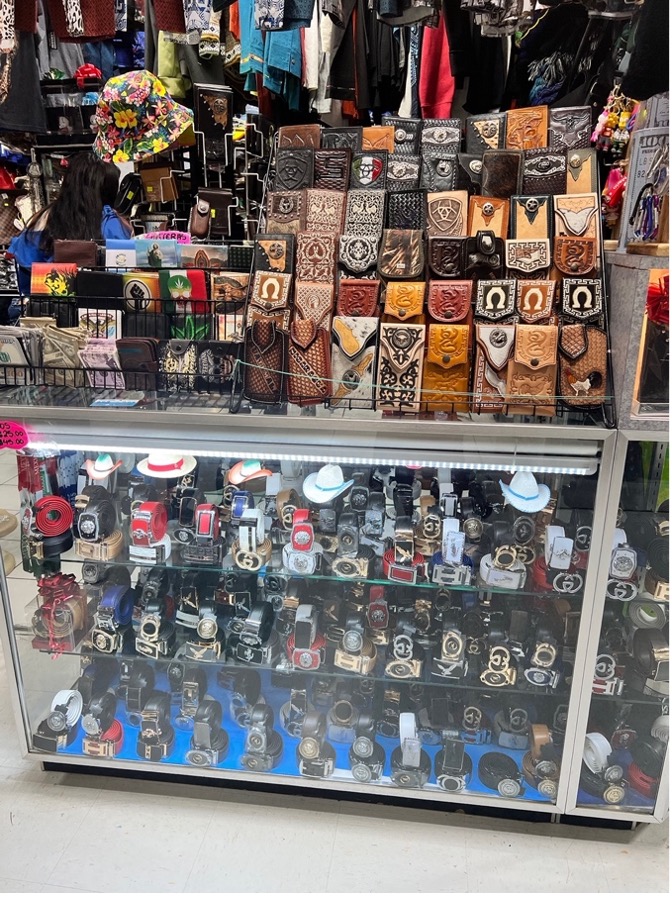
Retailers with Apparel for both Women and Men
Shops selling clothing for women and men make up slightly less than half of all clothing stores at Plaza Fiesta. However, though these retailers do not label their stores as exclusively carrying women’s or men’s wear, some shops appeared to lean more towards one direction or the other of this binary-gender spectrum based on the type of clothing they sold. Relying predominantly on the types of items observed at the shops that labeled themselves for one of these two genders and other contexts, I noted whether a particular shop seemingly marketed more towards women or men.
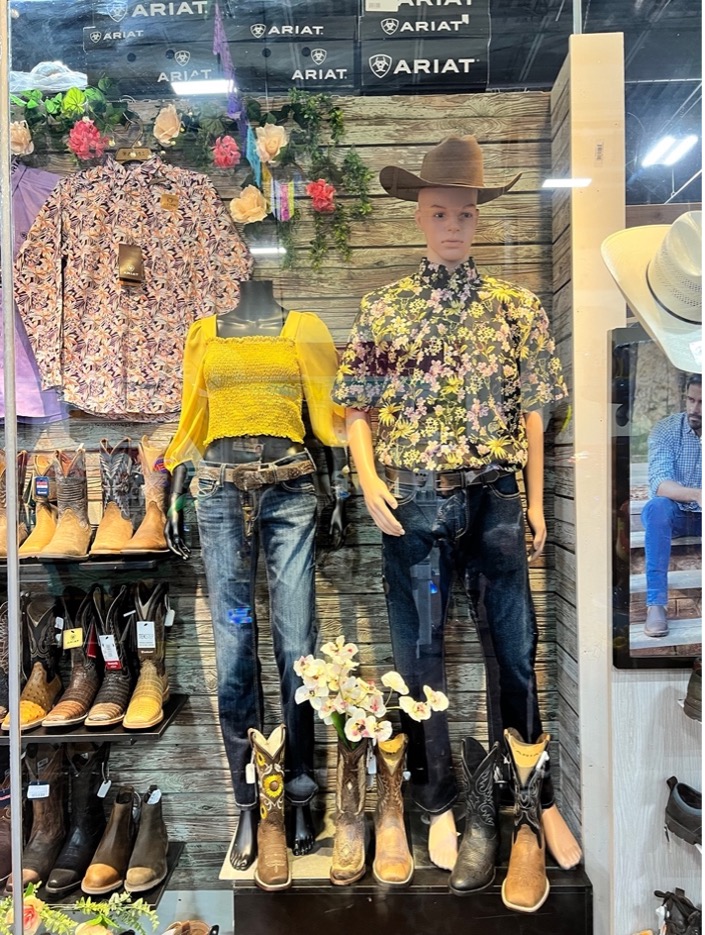
Thirteen of these twenty-one retailers sold casual wear. For the observations in this section, this includes five (5) trendy/urban apparel, four (4) sports apparel, three (3) western wear, and one (1) punk-rock attire shop(s). For the most part, the trendy/urban and punk-rock attire shops catered about evenly to women and men. At some of these shops, seemingly female and male mannequins would often be placed side-by-side, dressed in complementary outfits or women’s and men’s clothing would hang from the storefront in approximately equal quantities. When it came to the western wear shops, I also observed the female/male mannequin combination. However, upon a deeper inspection of these shops, much of the clothing seemed to fit traditionally male wardrobes. It appeared to me that while the western-wear stores were for women and men, there was much more variety when it came to women’s shoes at these stores than other types of clothing articles, based on the items most visibly on display. Furthermore, shops that sold sports apparel, which predominantly catered to soccer over any other sport, also appeared much more “male-coded” to me. One intriguing observation was that of the two stores in Plaza Fiesta that sold traditional clothing items, contained “sport” in its name, though not appearing to be a sports-wear store. The first clothing articles you see displayed at this store are traditional Mexican dress, traditionally an item exclusive to women. Inside, however, you can see they also sell soccer jerseys. It is intriguing to consider that, perhaps, because of the choice to also sell soccer jerseys, this shop is no longer exclusively women’s wear but also men’s wear. This is not to suggest that soccer jerseys are clothing articles that are exclusive to men, but this would follow common gender-stereotypes, and, it is worth mentioning, that all the soccer jerseys belonging to official teams I saw at Plaza Fiesta were of male teams.
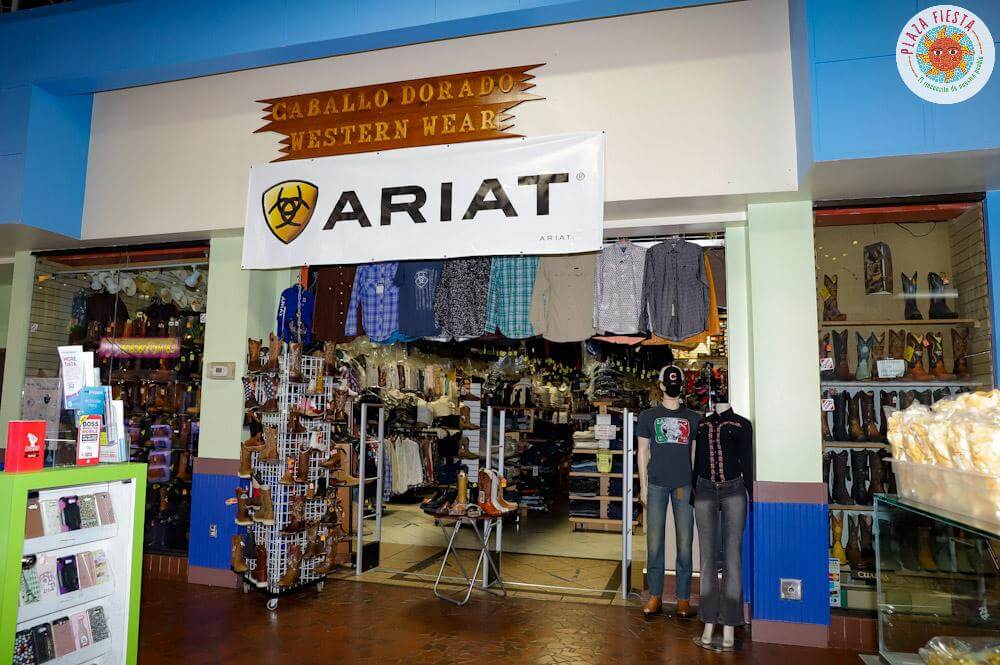
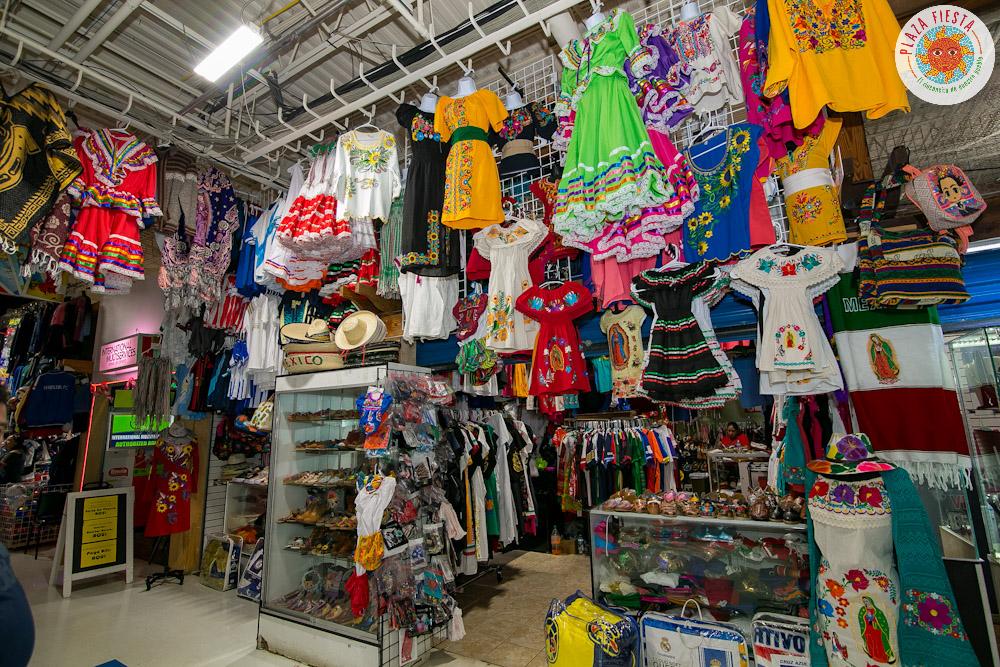
A final observation I made while browsing through the stores for women’s and men’s wear was the articles of clothing available at three (3) shops that exclusively sold work-uniforms. Mindfully, these were the only shops in Plaza Fiesta that sold these clothing items. Of the three, two shops sold chef’s uniforms and other uniforms related to this industry, such as waiter uniforms. And, excluding shoes, one sold this type of uniform exclusively. More, two sold construction work uniforms and/or safety-work wear. Again, excluding shoes, one store sold this type of uniform exclusively. Once again, though none of the three shops label themselves exclusive to one gender, all three were predominantly “male coded.” Firstly, one of the main telling signs of this are the patterns/cuts of the clothing sold here as well as the range in sizes available. Particularly the button-up shirts part of the waiter-uniform indicated they were, per traditional designs, meant for men given the shirt’s buttons were on the right-side. Secondly, when considering the store that exclusively sold construction uniforms, the storefront display was t-shirts cut in men’s patterns meaning, thicker fabrics, higher necklines, longer sleeves, and less defined (if at all) waist and hip lines. Finally, one additional observation made was that at the shop that sold both uniform types, there were also several cooking aprons on display. Per its pattern, which followed an A-Line-like cut (a common cut for dresses), and the way the t-shirt underneath it was cinched back at the waist, this appeared to be the only item aimed for women at this shop, besides non-slip work shoes. The difference in the types and styles of uniforms for the same tasks, in this case cooking, apparently targeted for men versus women here was quite intriguing.
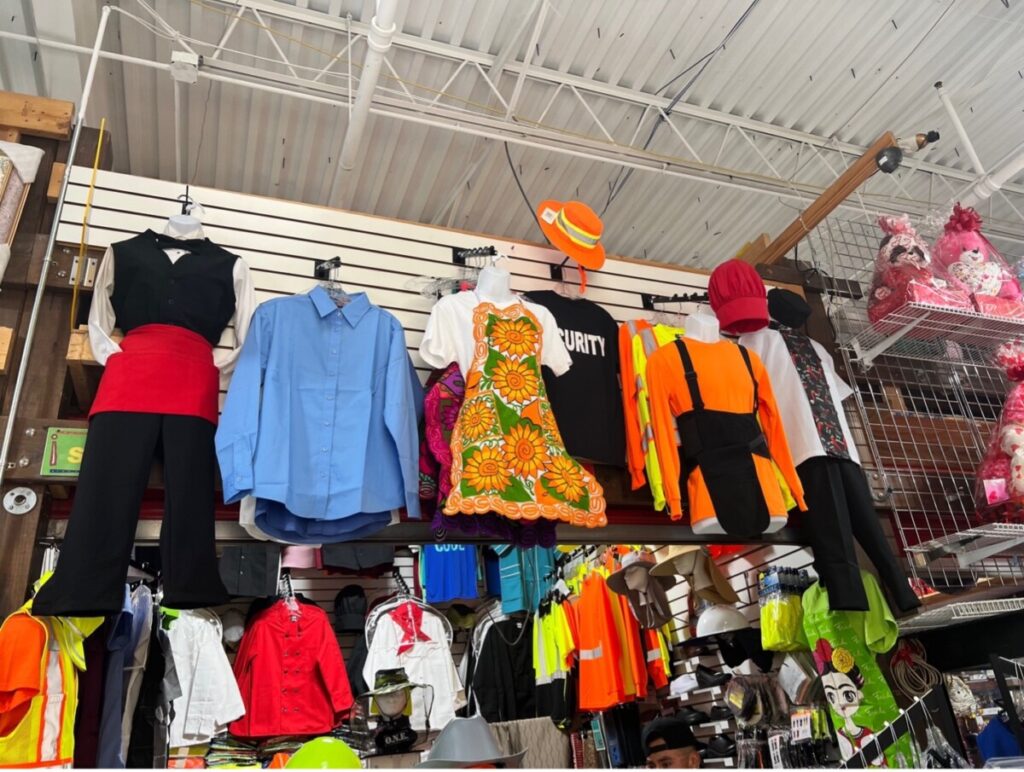
Reflections
In summary, my main takeaway from this small-scale research of clothing items at Plaza Fiesta was how interesting it was to browse through such a niche marketplace when it came to the styles of clothing available there. Particularly, in my previous experiences at larger, chain malls, and even smaller malls, I had never seen so many shops and boutiques where you could shop for occasion specific events, like Quinceñeras, in one place before. Moreover, I found it challenging yet, nonetheless, interesting to actively look for how gender-based identities are seen and represented in a conceived space (or, alternatively, are not seen/represented if we were to expand past the scope of binary-gender). In future work, I would be interested in seeing if the clothing themes observed at Plaza Fiesta are also observed at other Latin American shopping centers or other non-ethnically marked shopping malls in Georgia.
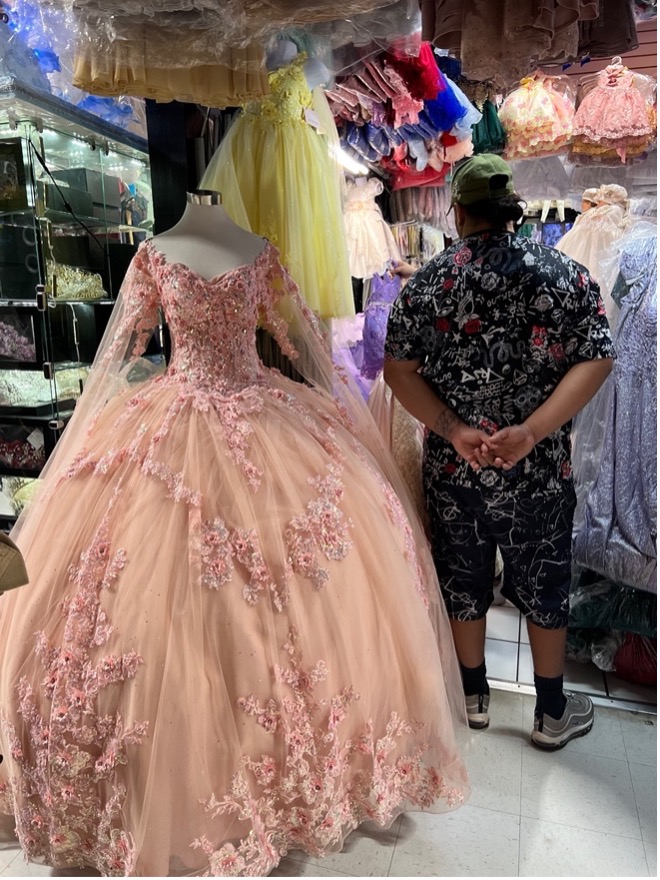
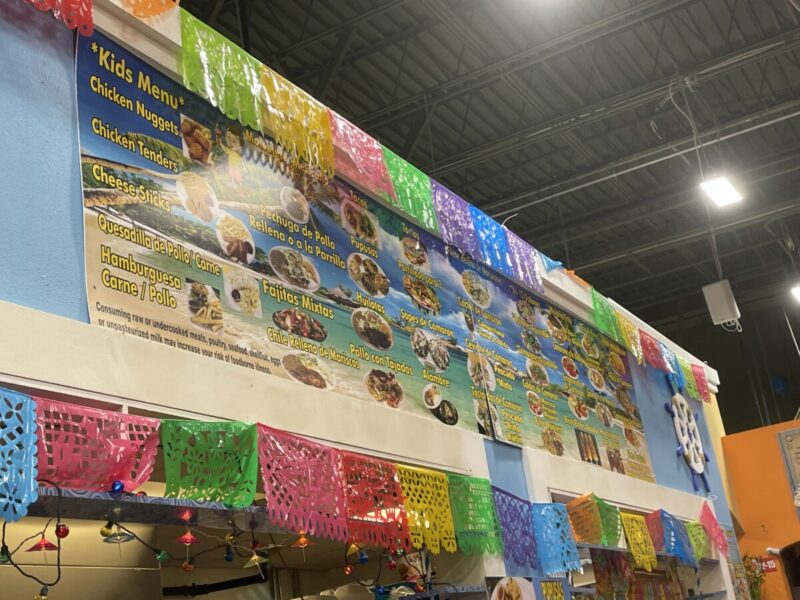
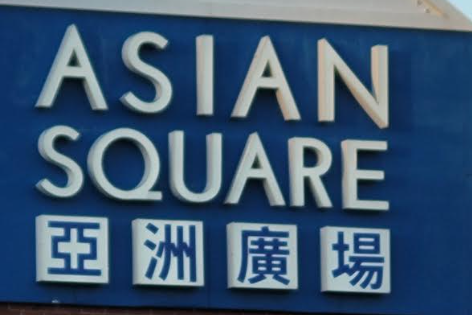
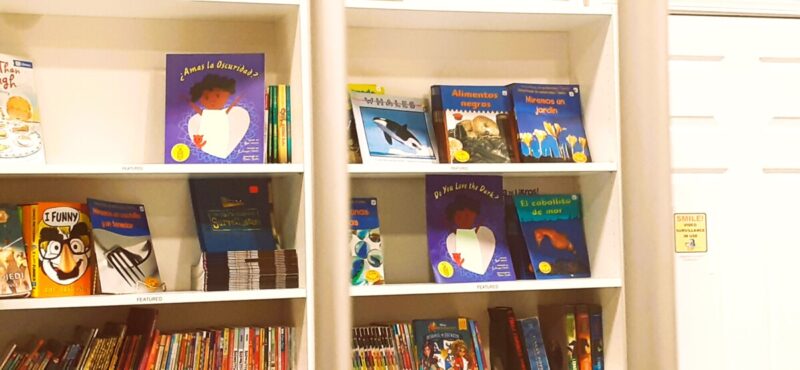
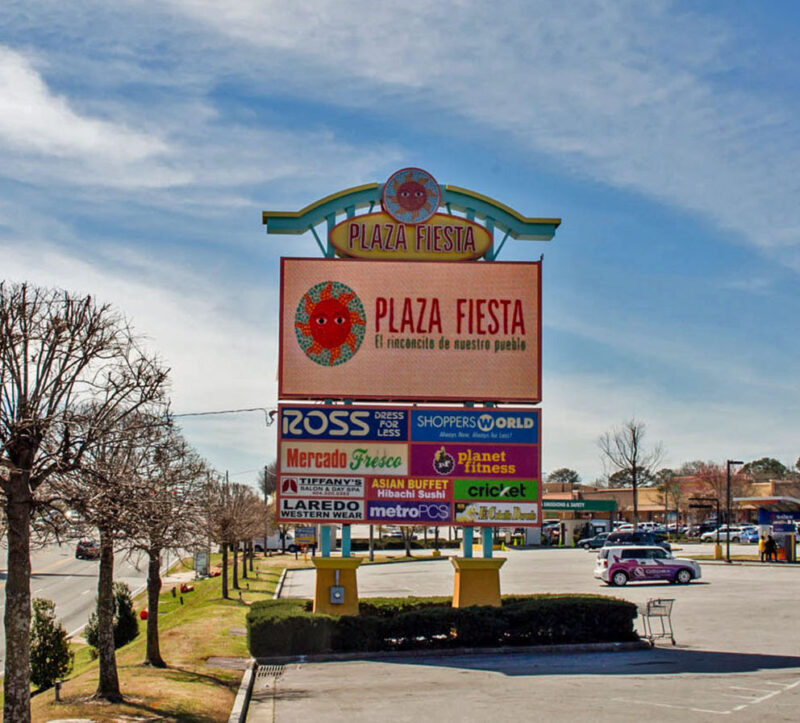
4 Comments
Add Yours →I enjoyed reading this. It was very thorough & insightful!
This is a thoughtful piece that I learned a lot from. It is always interesting to see how clothing is deeply connected to the cultures of Latin American countries for men and women.
It was a very original take on the landscape of Plaza Fiesta and I think you astutely noticed the specifities of men’s and women’s clothing. I was also striked by how many Western Wear places there were in the mall, considering I didn’t even know Western Wear was a thing in the first place.
I found your observations about the differences in not only the types but also the materials of the work uniforms available at coed stores to be very insightful, as it was not something I had previously noticed, but you draw attention to a very good point.